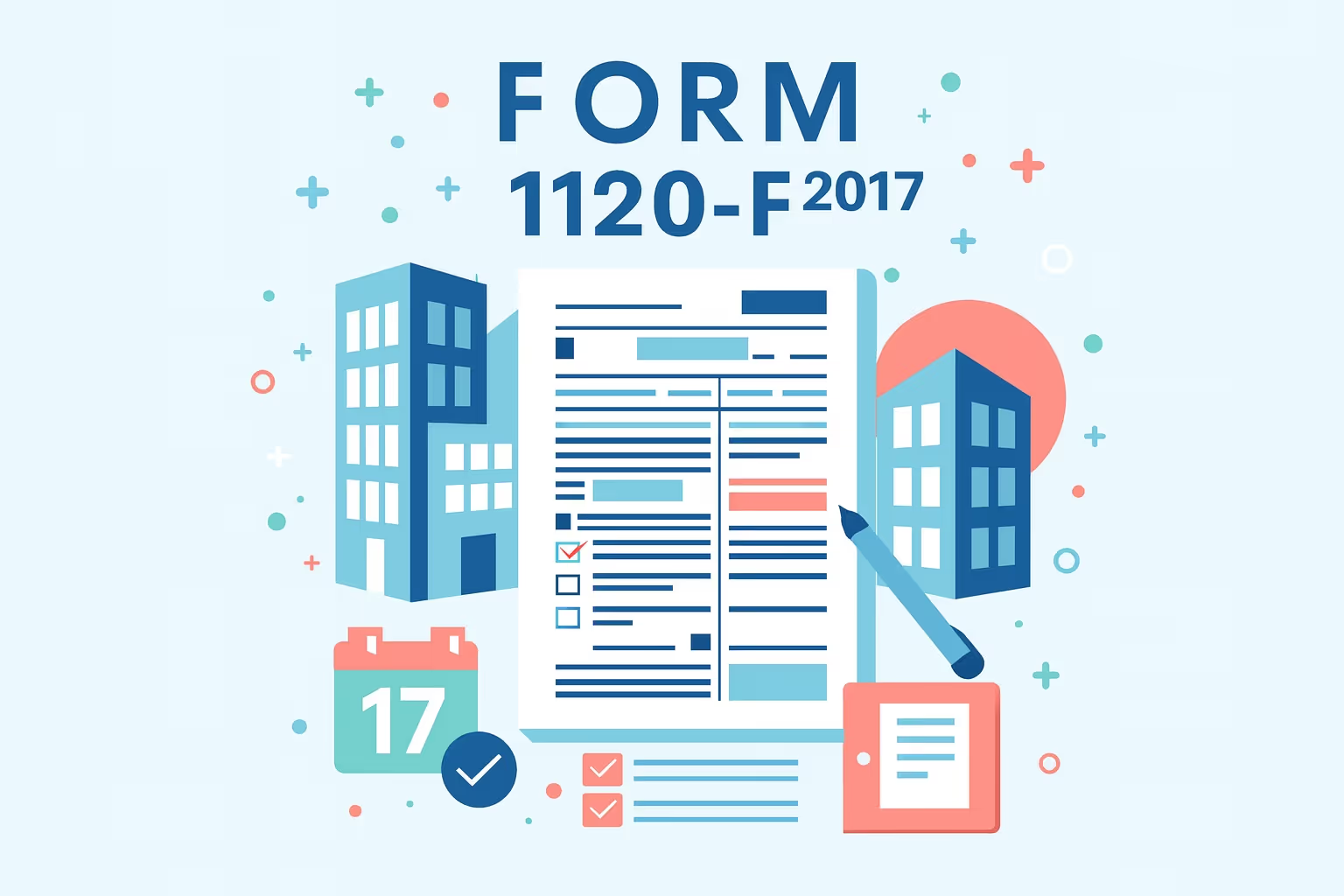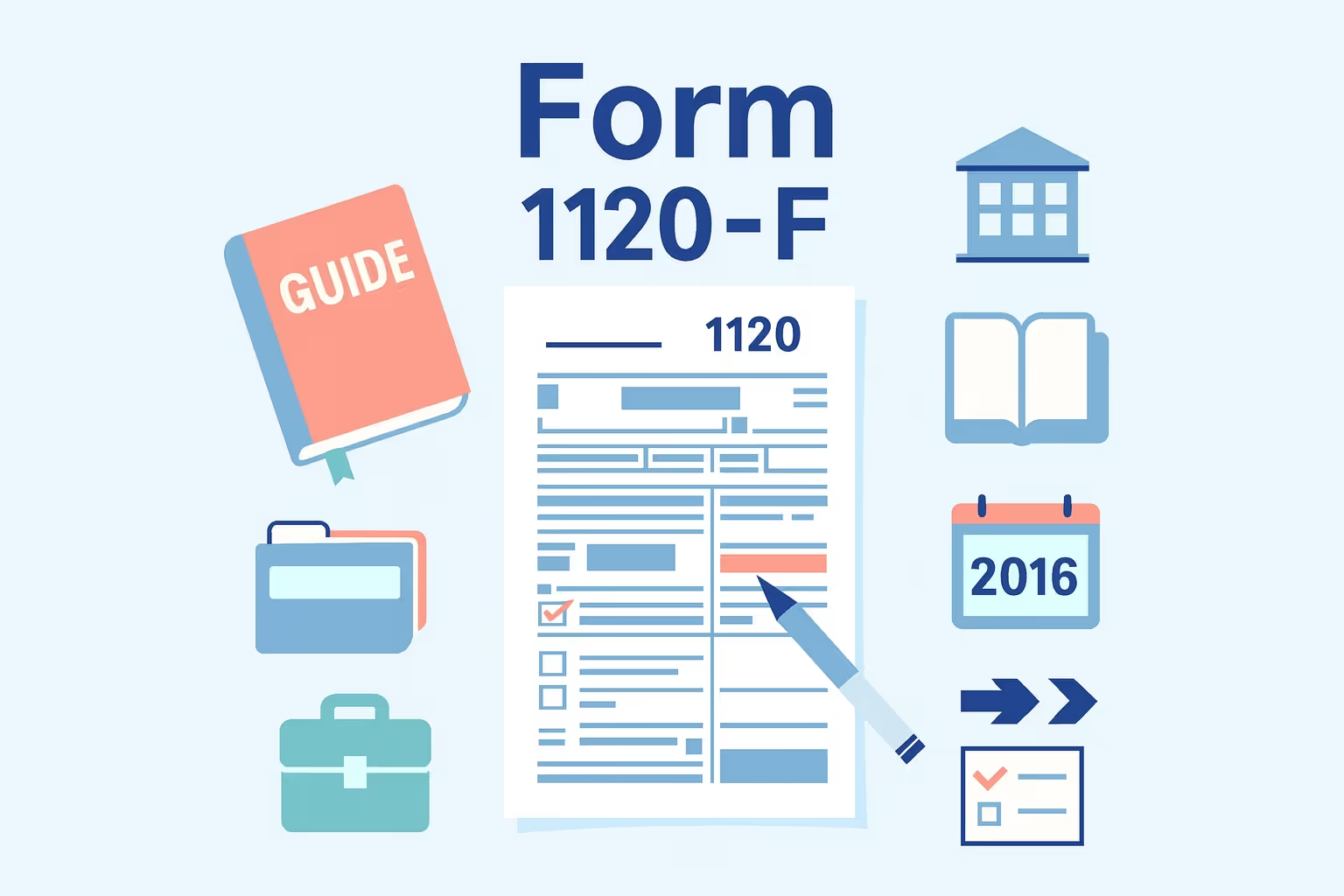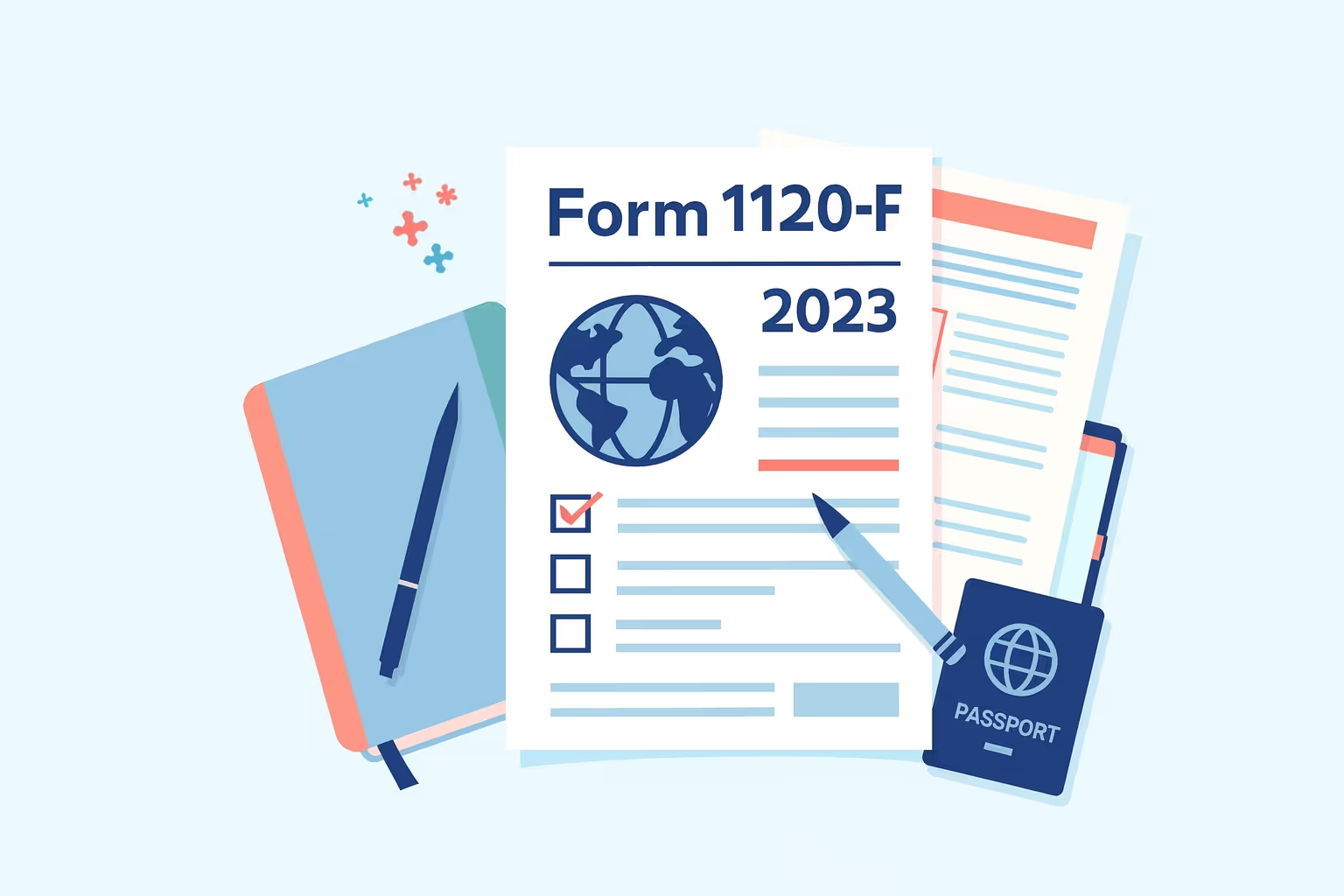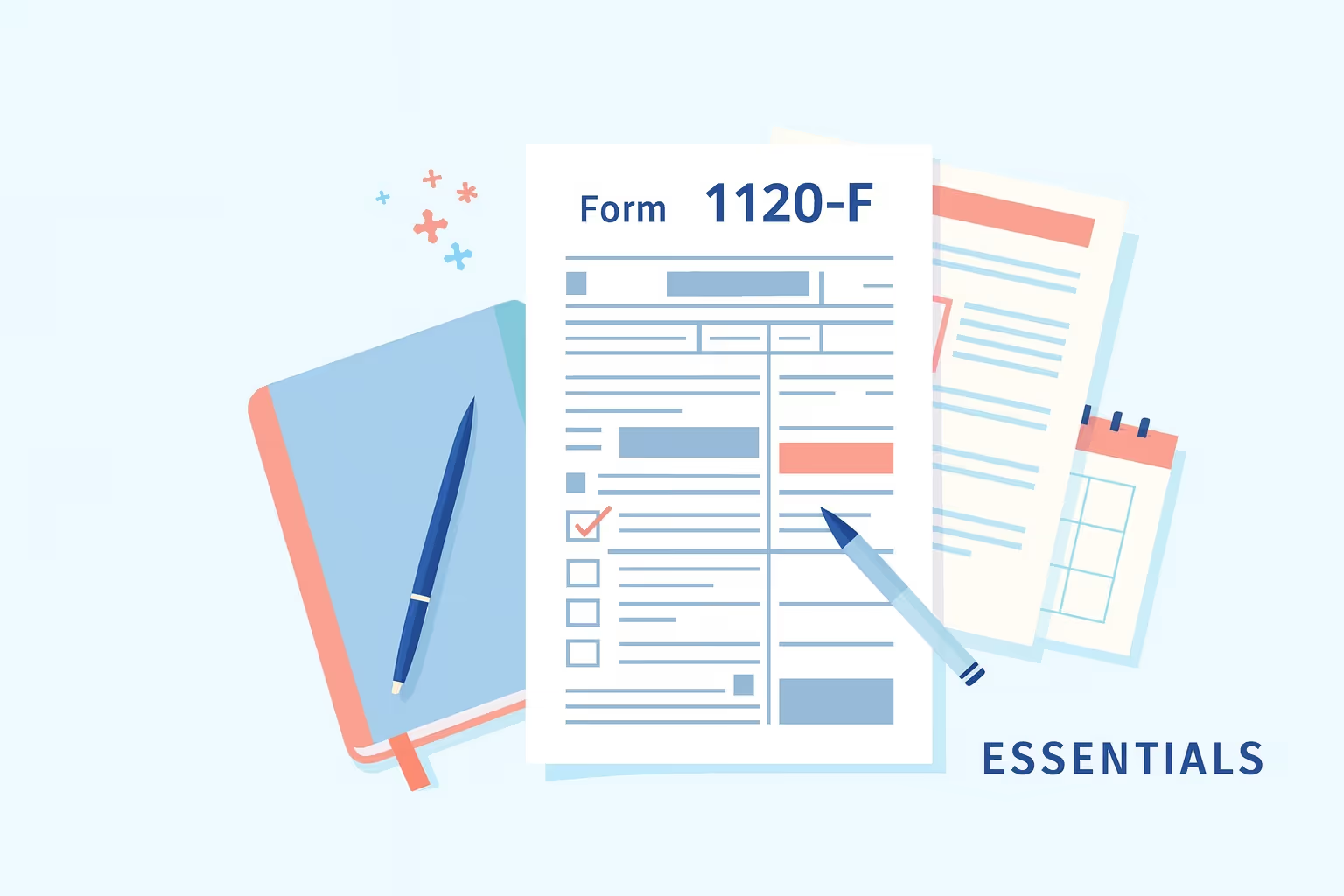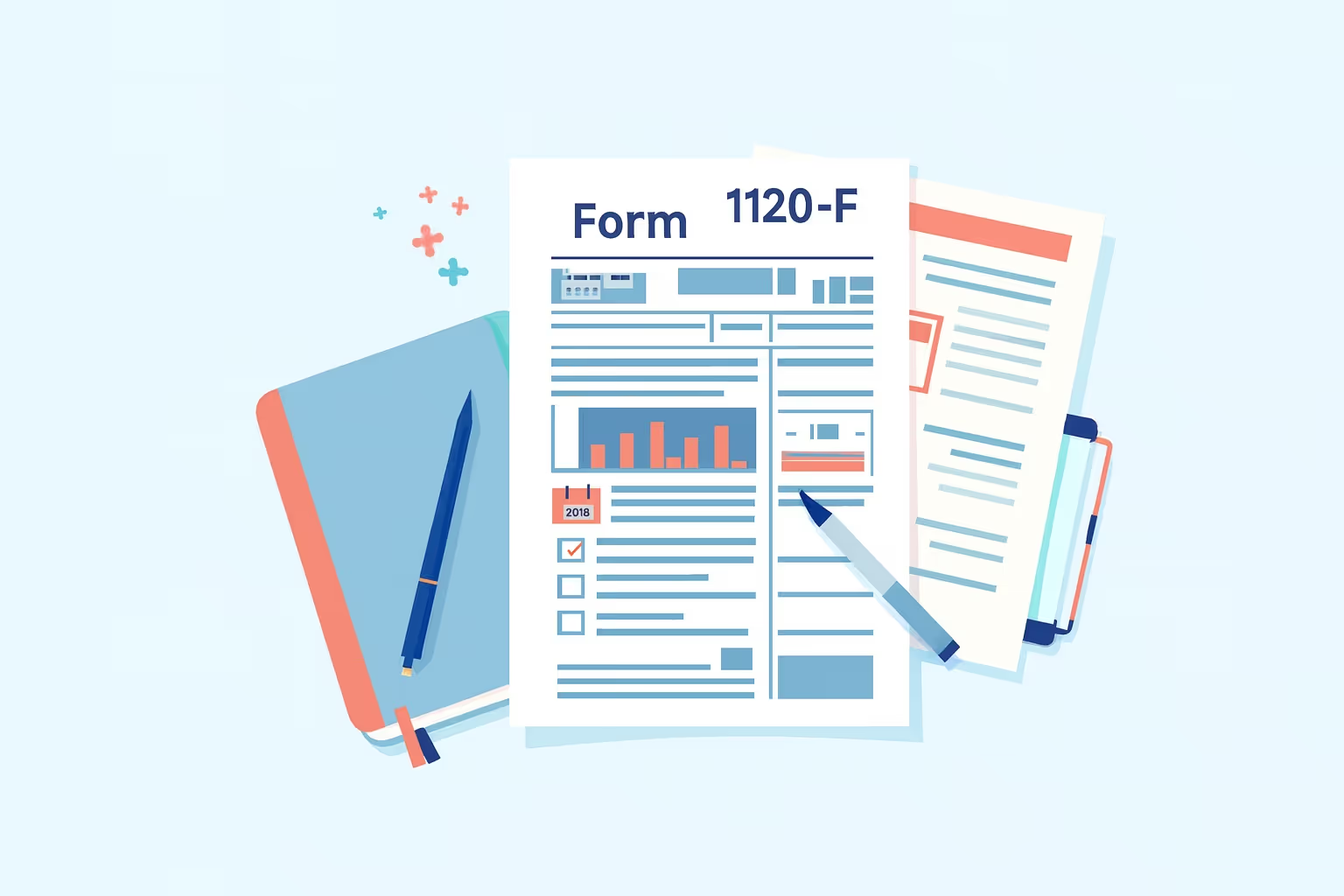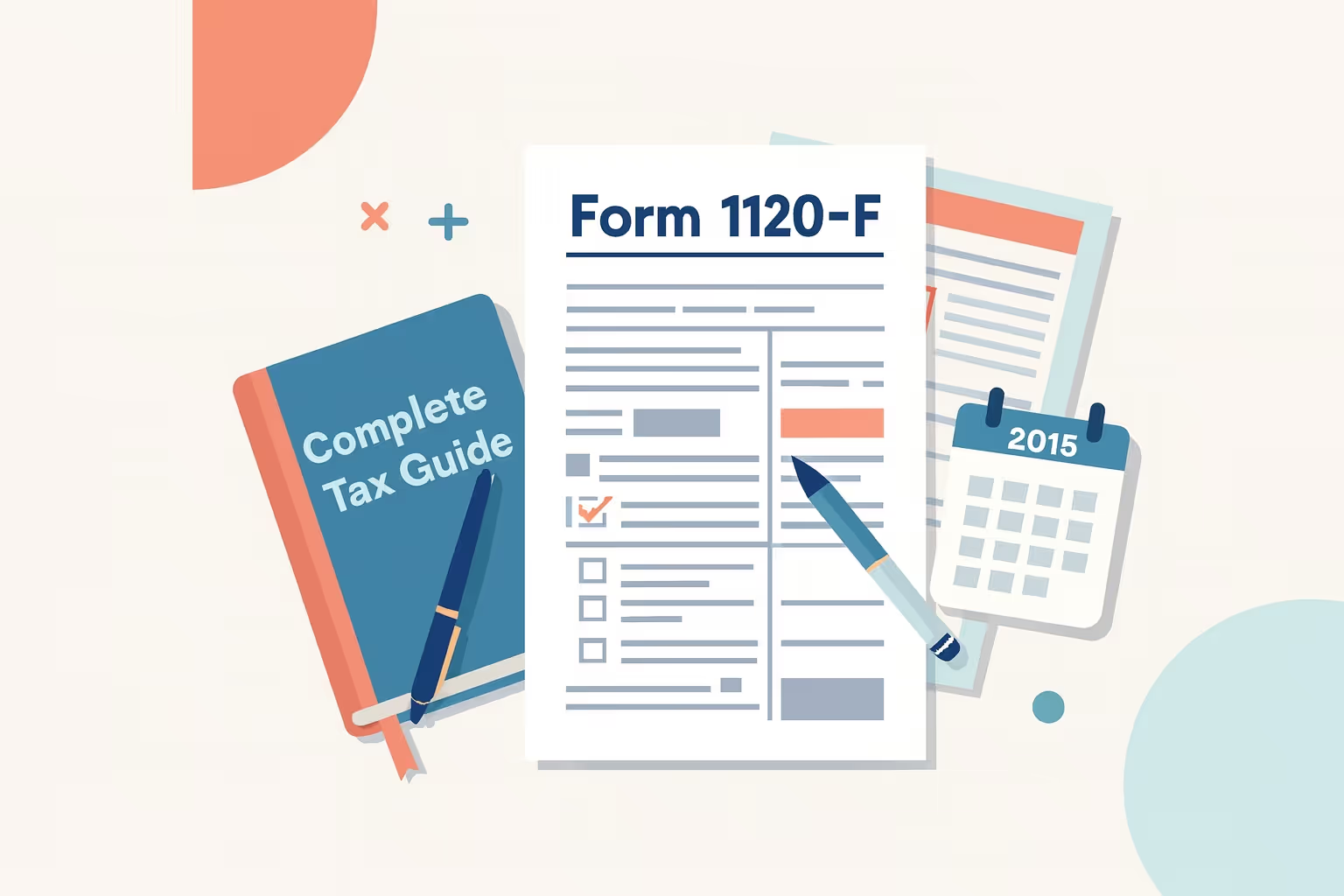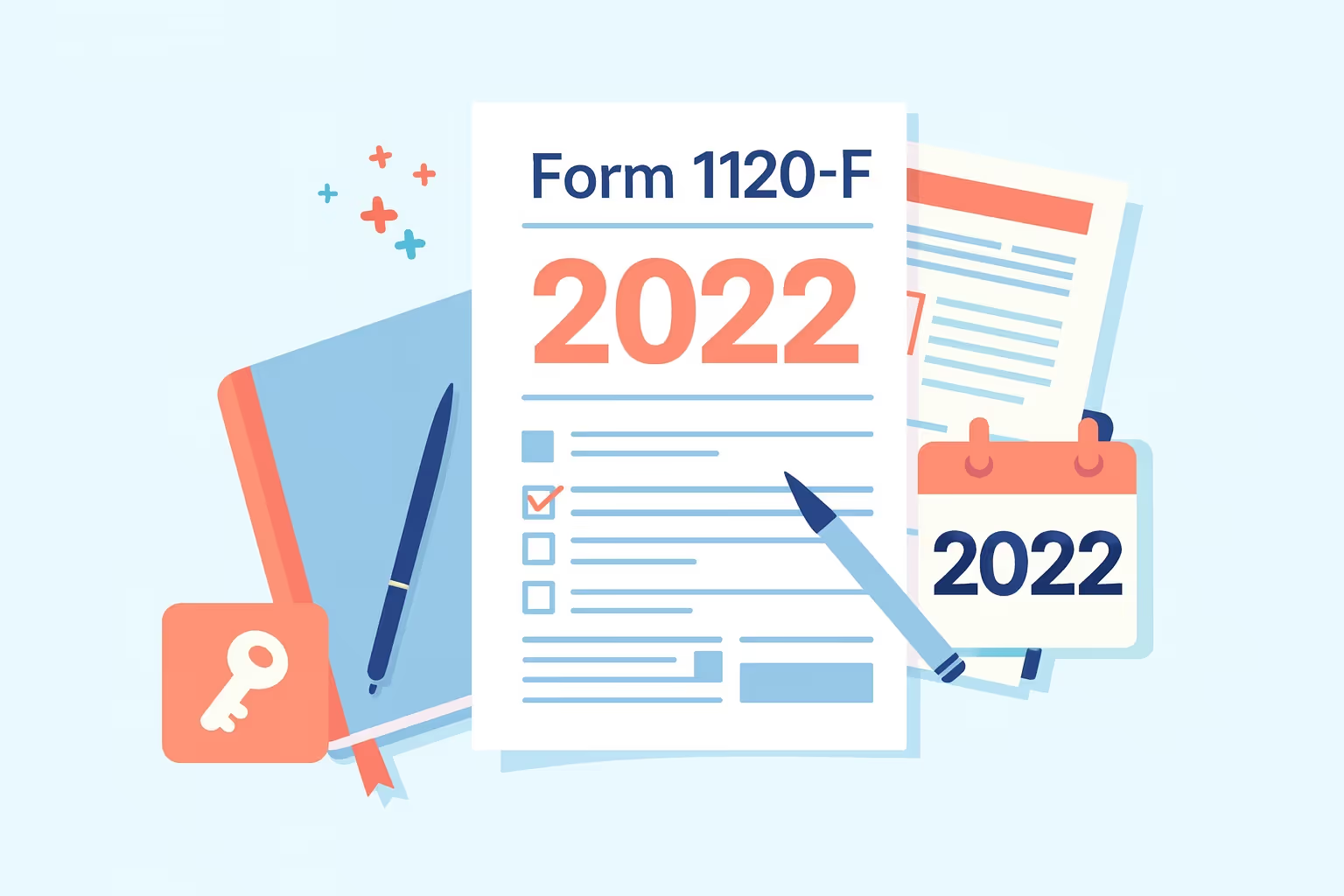
Filing a U.S. income tax return can be challenging for foreign corporations with business activities in the United States. Form 1120-F, officially titled U.S. Income Tax Return of a Foreign Corporation, is used to report income, deductions, and credits tied to U.S. operations. It determines tax liability on effectively connected income—income earned through business conducted within the country. Completing this form correctly ensures compliance with federal tax laws and helps corporations avoid penalties or delays.
For the 2020 tax year, the IRS introduced special rules under the CARES Act and the Families First Coronavirus Response Act (FFCRA). These temporary provisions allowed expanded deductions and payroll-related credits that impacted how taxable income was calculated. Using outdated instructions or missing these adjustments could result in filing errors or rejected returns.
This guide provides clear, step-by-step instructions to help foreign corporations accurately complete Form 1120-F for 2020. It explains who must file, what documentation to prepare, and how to complete each section, including required schedules and attachments. It also covers payment deadlines, exceptional filing cases, and common mistakes. Each part is written to make complex IRS requirements straightforward, ensuring corporations meet all compliance obligations confidently and correctly.
What Is Form 1120-F and Who Must File?
Filing Form 1120-F is a key part of how foreign corporations meet U.S. tax obligations when they conduct business in the United States. The form’s official title, U.S. Income Tax Return of a Foreign Corporation, reflects its purpose: to report income, deductions, and tax credits so the Internal Revenue Service (IRS) can determine its U.S. tax liability. It applies to any business with income effectively connected with a trade or business in the United States. You can review the official IRS instructions for this Form 1120-F.
Understanding Form 1120-F
Form 1120-F is a tax and compliance document for foreign corporations conducting business in the United States. It allows a corporation to report several key details to the IRS:
- Business income and deductions: The form records income earned and deductions related to U.S. operations, ensuring all taxable activities are accurately reported.
- Taxes withheld or paid: It documents taxes already withheld or paid on U.S.-source income, verifying that required payments were made in compliance with federal rules.
- Credits, adjustments, and treaty benefits: Corporations use the form to claim applicable credits, adjustments, and tax treaty benefits that may reduce their overall U.S. tax liability.
Filing Form 1120-F maintains transparency with the IRS and protects a corporation’s right to claim deductions, credits, and refunds associated with its U.S. activities.
Who Is Required to File
Foreign corporations generally must file Form 1120-F if they:
- Engage in any trade or business within the United States, whether or not income was earned.
- Income, gains, or losses should be treated as effectively connected with U.S. activities.
- Claim a refund of overpaid tax or report treaty-based positions.
- Operate as a Qualified Derivatives Dealer (QDD) or maintain a U.S. branch.
Exceptions From Filing
Certain exceptions apply when a foreign corporation’s U.S. activities are limited. Filing may not be required if the corporation:
- It has no U.S. trade or business, and all taxes on U.S.-sourced income were entirely withheld.
- Receives only exempt income under sections 881(c) or (d).
- Is a beneficiary of an estate or trust engaged in a U.S. trade or business, but has no direct filing requirement.
Failing to file Form 1120-F when required can result in the loss of deductions, credits, or treaty benefits. Even if no tax is due, submitting the form helps maintain compliance and preserves the corporation’s standing with the IRS.
What’s New for the 2020 Tax Year
The 2020 tax year brought temporary changes to Form 1120-F through the CARES Act and FFCRA. These COVID-19 relief laws introduced expanded deductions, loss carryback options, and payroll-related credits, significantly affecting how foreign corporations calculated and reported income on their U.S. tax returns for that year. For reference, you can view IRS updates and filing resources.
CARES Act Provisions
The CARES Act temporarily expanded certain deductions and credits to help corporations offset 2020 business losses and expenses. Key updates included:
- Expanded charitable contribution limit: Corporations could deduct cash contributions of up to 25% of taxable income, an increase from the previous 10% limit. This change applies to qualified donations made during 2020 and 2021.
- Net Operating Loss (NOL) carryback rule: Corporations were allowed to carry back losses from 2018, 2019, or 2020 up to five years, helping them recover taxes previously paid.
- Increased food inventory deductions: The limit for deducting contributions of food inventory rose from 15% to 25% of taxable income or aggregate net income from trades or businesses.
- Employee Retention Credit (ERC): Eligible corporations could claim a credit for qualified wages paid to employees during periods of business interruption. Wages used for the ERC could not be counted toward other credits or deductions.
FFCRA Provisions
The FFCRA also affected 2020 filings by providing payroll-related relief:
- Payroll tax credits for required leave: Employers could claim credits for wages paid to employees taking qualified sick or family leave due to COVID-19. These credits offset payroll taxes but had to be reported as income on Form 1120-F, Section II, Line 10.
- Reporting caution: Corporations needed to ensure that amounts claimed as FFCRA credits were accurately recorded as taxable income to maintain compliance and avoid duplication with other relief programs.
These provisions reduced taxable business income and supported corporations managing pandemic-related expenses. However, each change carried specific documentation and reporting rules, making it critical for filers to closely review the 2020 Form 1120-F instructions before submitting their return.
Step-by-Step Instructions for Completing Form 1120-F
Step 1 — Gather Required Information
- Preparing Form 1120-F can be challenging for foreign corporations with business activities in the United States. Errors often arise from income misclassification, missing schedules, or late payments.
- Many corporations confuse effectively connected income (ECI) with fixed, determinable, annual, or periodical (FDAP) income. ECI relates to U.S. business operations and allows deductions, while FDAP is passive income taxed flatly. Always classify income based on the extent of U.S. activity.
- In addition, missing schedules such as Schedule H or Schedule I can lead to denied deductions. Filing a protective return preserves future credits, and timely payments prevent penalties.
Step 2 — Complete Header and Items A–G
- Ensure that the legal name, address, and EIN are entered exactly as they appear in official records to facilitate matching your account with the IRS.
- Report the country of incorporation, date, and total assets at year-end to establish the entity profile and scale.
- Identify the principal business activity and NAICS code to describe your U.S. business operations.
- Disclose the location of the books and records and the name and address of your U.S. agent, if you have appointed one.
- Indicate controlled foreign corporation status, if applicable, because this status may affect disclosures and forms.
- Confirm any changes, such as an initial return, final return, or address change, to maintain a clean filing history.
Step 3 — Section I: Income Not Effectively Connected (FDAP)
- Use Section I to report U.S.-source income not effectively connected with a U.S. trade or business, such as specific interest and dividends.
- Enter gross amounts, apply the statutory 30% or the applicable treaty rate, and calculate the tax due in the provided column.
- Report amounts withheld at source and reconcile them with Forms 1042-S to avoid duplicate tax or mismatches.
- Do not report the same income in Section II because double reporting causes processing issues and potential notices.
Step 4 — Section II: Effectively Connected Income (ECI)
- Include business income from U.S. operations, capital gains that are ECI, and partnership ECI passed through on Schedules K-1.
- Report payroll-related credits from 2020 relief as income on line 10, consistent with instructions from Form 1120-F 2020.
- Claim deductions on lines 12–30, including ordinary and necessary expenses, charitable contributions, and the NOL deduction for the tax year.
- Apply 2020 rules where relevant, such as the increased charitable contribution limit and NOL carryback provisions.
- Allocate and compute interest expense using Schedule I, and allocate other expenses to ECI using Schedule H so deductions are properly apportioned.
- As required, reconcile book-to-tax differences on Schedule M-1 or M-3 to support your taxable income calculation.
Step 5 — Section III: Branch Profits Tax
- Determine the dividend equivalent amount based on effectively connected earnings and profits for the period.
- Apply the 30% branch profits tax at a reduced treaty rate when your corporation qualifies under a treaty’s limitation-on-benefits article.
- Maintain documentation supporting treaty eligibility and computations, including schedules showing earnings, distributions, and U.S. net equity changes.
- Coordinate this section with your ECI results because the branch profits tax depends on profits not retained in U.S. assets.
Before you file, review math, names, and EINs; confirm treaty claims; and ensure all schedules and statements match the positions in Sections I–III. This final check helps foreign corporations file an accurate income tax return and reduces the risk of notices or processing delays.
Required Schedules and Attachments
Form 1120-F requires schedules and attachments detailing a corporation’s U.S. activities, income types, deductions, and credits. These documents support reported figures and confirm how U.S. income tax was imposed.
Always Required Schedules
Some schedules apply to nearly every filing, regardless of the corporation’s size or activity level:
- Schedule L – Balance Sheets: This schedule provides the beginning and end-of-year balance sheets, showing changes in assets, liabilities, and equity. It reflects property, cash, and other holdings used in U.S. operations.
- Schedule M-1 or M-3 – Reconciliation of Income: These schedules reconcile book income with taxable income, ensuring that financial results match IRS rules. Schedule M-3 is required if total assets exceed $10 million at year-end.
Commonly Required Schedules
Certain attachments apply when the corporation reports specific deductions, interest, or related-party transactions:
- Schedule H – Deductions Allocated to Effectively Connected Income: Used to show how expenses were assigned between effectively connected and non-effectively connected income.
- Schedule I – Interest Expense Allocation: Reports how interest deductions were determined and applied.
- Form 5472 – Related Party Transactions: Lists reportable transactions between the corporation and foreign or domestic affiliates.
- Form 8833 – Treaty-Based Return Positions: Explains treaty provisions that decreased tax liability or changed how income was taxed.
- Form 8832 – Entity Classification Election: Filed when the corporation elects to change its tax classification for U.S. purposes.
Situational Attachments
Some schedules apply only when special activities or elections occur:
- Schedule P – Foreign Partner Interests in Partnerships: Required if the corporation holds partnership interests that generate U.S. income.
- Schedule S—applies to International Shipping or Aircraft Income: Applies when a corporation claims exemptions for shipping or aircraft sales or services.
- Form 8886 – Reportable Transactions: Filed for participation in transactions with potential tax avoidance characteristics.
Review all schedules before filing to confirm accuracy, signatures, and dates. Ensure totals match the main form, as missing or incomplete attachments can delay processing and trigger IRS compliance inquiries.
Filing Options: Electronic vs. Paper Filing
Foreign corporations completing Form 1120-F for the 2020 tax year can choose between electronic and paper filing, depending on their size and filing requirements. The IRS encourages electronic filing for accuracy and faster processing, but certain smaller corporations may still prefer paper submission.
Electronic Filing (E-File)
Corporations with total assets of $10 million or more or those filing at least 250 returns annually must file electronically. Smaller corporations can choose to e-file voluntarily. E-filing offers several advantages, including:
- Fewer errors: IRS-approved software automatically checks for missing information and math inconsistencies.
- Faster confirmation: Corporations receive an electronic acknowledgment that the return has been accepted.
- Convenient payment options: When filing, you can withdraw electronic funds or Electronic Federal Tax Payment System (EFTPS) payments.
- Secure submission: E-filing protects sensitive financial and tax data through encrypted transmission.
To e-file, corporations must use IRS-authorized software or a professional tax service. All schedules, attachments, and signatures should be submitted electronically to the main form.
Paper Filing
Corporations required to e-file can mail their completed return to the Internal Revenue Service Center in Ogden, Utah. When filing by mail:
- Use black ink or typewritten text for clarity.
- Attach all required schedules and statements.
- Sign and date the return before submission.
- Use certified mail or a reliable courier service for proof of timely filing.
Whether filed electronically or on paper, accuracy and completeness are essential. A carefully prepared return helps ensure proper processing and maintains the corporation’s compliance with U.S. tax reporting requirements.
Paying Taxes and Meeting Deadlines for Your Income Tax Return
Foreign corporations filing Form 1120-F must ensure that all tax payments are made correctly and on time to comply with U.S. tax law. Payment rules differ depending on whether the corporation maintains a U.S. office or operates abroad. Missing a deadline or using the wrong payment method can lead to penalties and interest charges.
Corporations With a U.S. Office
Corporations that maintain an office or business in the United States must make federal tax deposits electronically through the Electronic Federal Tax Payment System (EFTPS). Payments must be scheduled before the due date, and corporations receive a confirmation number once the transaction is processed. This system tracks payments easily and ensures deposits are applied to the correct income tax return.
Corporations Without a U.S. Office
Foreign corporations without a U.S. office can choose from several payment options. They may pay through EFTPS if they have a U.S. bank account, use a qualified intermediary to pay, or send a check or money order payable to the United States Treasury. When mailing a payment, include the EIN, tax year, and a copy of the return to prevent processing delays.
Filing and Payment Deadlines
- With a U.S. office: Payment is due on the 15th day of the fourth month after the end of the tax year.
- Without a U.S. office: Payment is due on the 15th day of the sixth month after the end of the tax year.
- Fiscal-year filers ending June 30: Payment is due by the 15th day of the third month after the year-end.
Meeting these deadlines ensures the corporation remains in good standing and avoids penalties for late or incomplete payments.
Common Filing Mistakes and How to Avoid Them
Preparing Form 1120-F can be complex for foreign corporations, particularly when business activities extend into the United States. Filing errors often occur because of confusion about income reporting, missing schedules, or incomplete payments. Careful preparation ensures that the income tax return accurately reflects the subject corporation’s operations and obligations.
Common filing mistakes and how to prevent them:
- Misclassifying income: Many corporations confuse effectively connected income (ECI) with fixed, determinable, annual, or periodical (FDAP) income. ECI relates to U.S. business activities and allows deductions, while FDAP is passive income taxed flatly. Always confirm the correct section based on the extent of U.S. involvement.
- Missing required schedules: Omitting Schedule H (expense allocation) or Schedule I (interest expense) may result in disallowed deductions. In addition, review the filing checklist to ensure all schedules and attachments are complete.
- Failing to file a protective return: Filing a protective return safeguards the right to future deductions or credits when tax liability is uncertain.
- Payment errors: Late or incomplete payments often cause penalties. Confirm due dates, verify the EIN, and record payments properly through EFTPS or another approved system.
By identifying these issues early and maintaining organized records, corporations can avoid delays, preserve tax benefits, and remain in good standing with the IRS.
Special Filing Situations
Some foreign corporations face unique circumstances that affect how they file Form 1120-F. Whether the business is temporarily inactive or filing for the first time, understanding these situations helps maintain compliance and protect necessary tax rights.
Filing During Dormant or Zero-Activity Years
A foreign corporation may experience a year with little or no U.S. activity. Even in these cases, filing may still be required.
- When to file: A return is necessary if the corporation engaged in any U.S. trade or business, had U.S.-source income partially withheld at the source, or wishes to preserve the right to future deductions and credits.
- Protective returns: Corporations should submit a protective return if they are uncertain about the need to file. This simple filing ensures that the IRS recognizes the company’s status and maintains eligibility for deductions if its income later becomes taxable.
- Documentation: Include identifying details, treaty-based claims, and schedules such as Schedule L (Balance Sheets) or M-1 (Book-to-Tax Reconciliation).
First-Time Filers
Corporations filing Form 1120-F for the first time must take several necessary steps to ensure accuracy and compliance:
- Obtain an Employer Identification Number (EIN): Every foreign corporation must have an EIN before submitting its return. This number is the official tax identification for all correspondence and payments with the IRS.
- Establish an accounting method: A corporation must choose and apply a consistent accounting method. Most corporations use the accrual method, as it aligns income and expenses within the same tax period and supports transparent financial reporting.
- Gather supporting records: Before filing, corporations should collect all relevant financial documents, including financial statements, partnership Schedule K-1s, and treaty documentation. These records verify income sources, deductions, and eligibility for treaty benefits.
Completing these steps properly ensures that first-time filers maintain compliance and establish a reliable foundation for future U.S. tax reporting, even when their business activity or tax exposure is limited.
Maintaining Compliance After Filing
Once a foreign corporation files Form 1120-F, ongoing compliance becomes essential to avoid penalties and ensure accurate future reporting. Maintaining organized records and keeping information updated with the IRS supports smooth annual filings and protects the corporation’s tax standing.
- Recordkeeping requirements: Corporations should retain all tax records, schedules, and supporting documentation for at least three years after filing. These records must be readily available in case of an IRS inquiry or audit.
- Update business information: The IRS must be promptly informed of any changes in address, ownership, or the location of books and records. Accurate contact details prevent missed notices or delays in correspondence.
- Monitor tax law changes: The IRS regularly updates guidance for foreign corporations. Reviewing yearly updates helps ensure compliance with current requirements, especially when claiming deductions, credits, or treaty benefits.
- Stay current with state and local obligations: Beyond federal filing, corporations may have additional reporting responsibilities at the state or municipal level, depending on where they conduct business.
By maintaining complete records and staying informed about regulatory changes, corporations can preserve compliance and reduce risks associated with future filings.
Frequently Asked Questions (FAQs)
Who must file Form 1120-F for 2020?
Foreign corporations engaged in a U.S. trade or business or earning U.S.-source income generally must file Form 1120-F. Filing ensures the corporation can claim deductions and credits for effectively connected income. Even if no tax is owed, submitting the form before deadlines ensures compliance once it arrives at the Internal Revenue Service.
What’s the difference between ECI and FDAP income?
Effectively connected income (ECI) comes from active business operations in the United States and allows deductions. Fixed, determinable, annual, or periodical (FDAP) income is passive income taxed at a flat 30% rate, such as dividends or interest. Reporting the correct type ensures that income is classified correctly when the return arrives at the IRS.
When is Form 1120-F due?
Corporations with a U.S. office must file by the 15th day of the fourth month after the tax year ends. Those without a U.S. office must file by the 15th day of the sixth month. Fiscal-year corporations ending June 30 must file by the 15th day of the third month.
Can a foreign corporation e-file Form 1120-F?
Yes, corporations with assets exceeding $10 million or filing at least 250 returns annually must e-file. Smaller corporations may do so voluntarily. Electronic filing provides faster confirmation and secure data transfer, ensuring the form arrives promptly at the IRS. It also reduces processing errors and provides proof of timely submission.
What are the 2020 CARES Act changes relevant to Form 1120-F?
For 2020, corporations could deduct charitable contributions up to 25% of taxable income, apply a five-year carryback for net operating losses, and claim payroll-related credits. These temporary provisions aimed to ease the financial impact of COVID-19 on businesses. Including these deductions correctly helps ensure accurate results when the return arrives at the IRS.




















